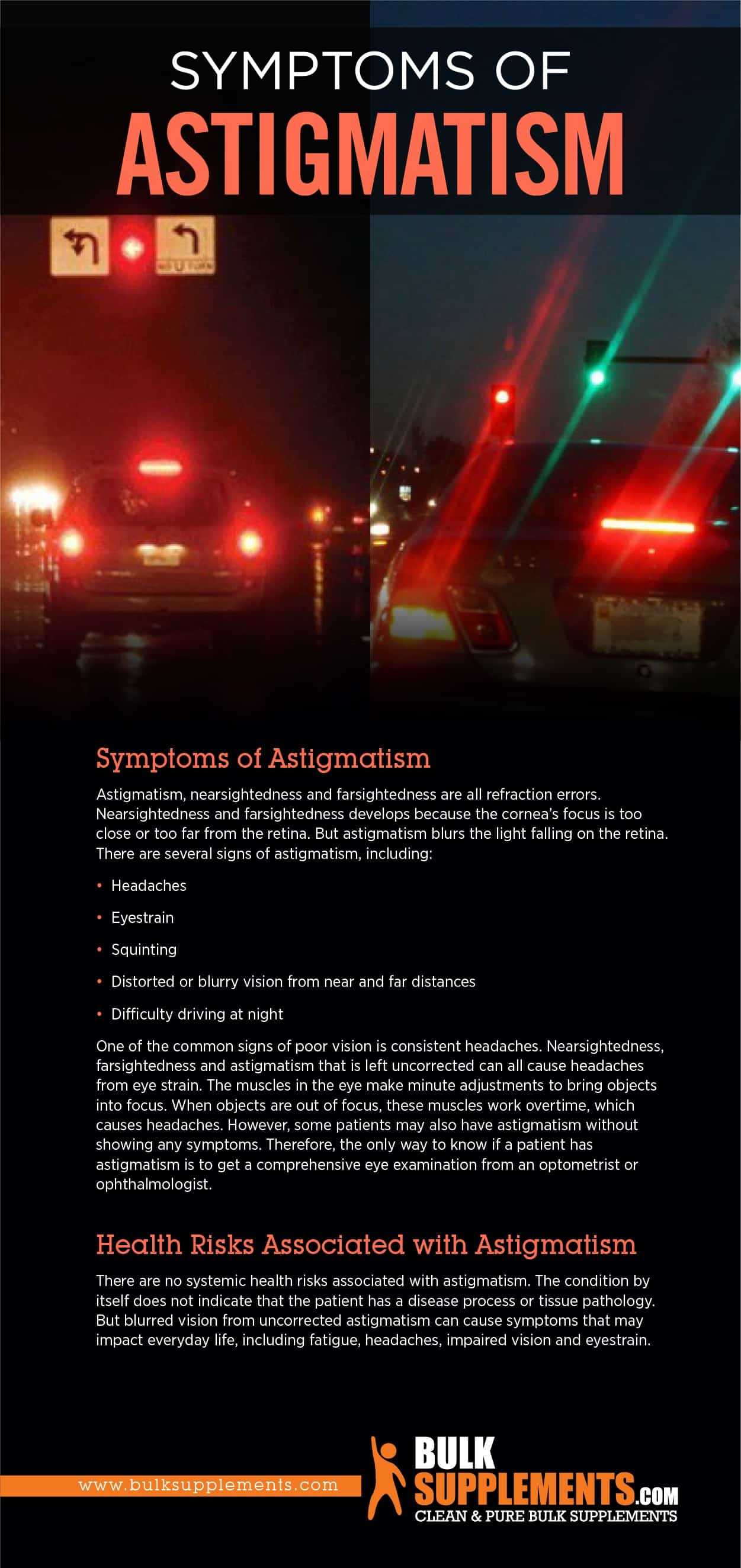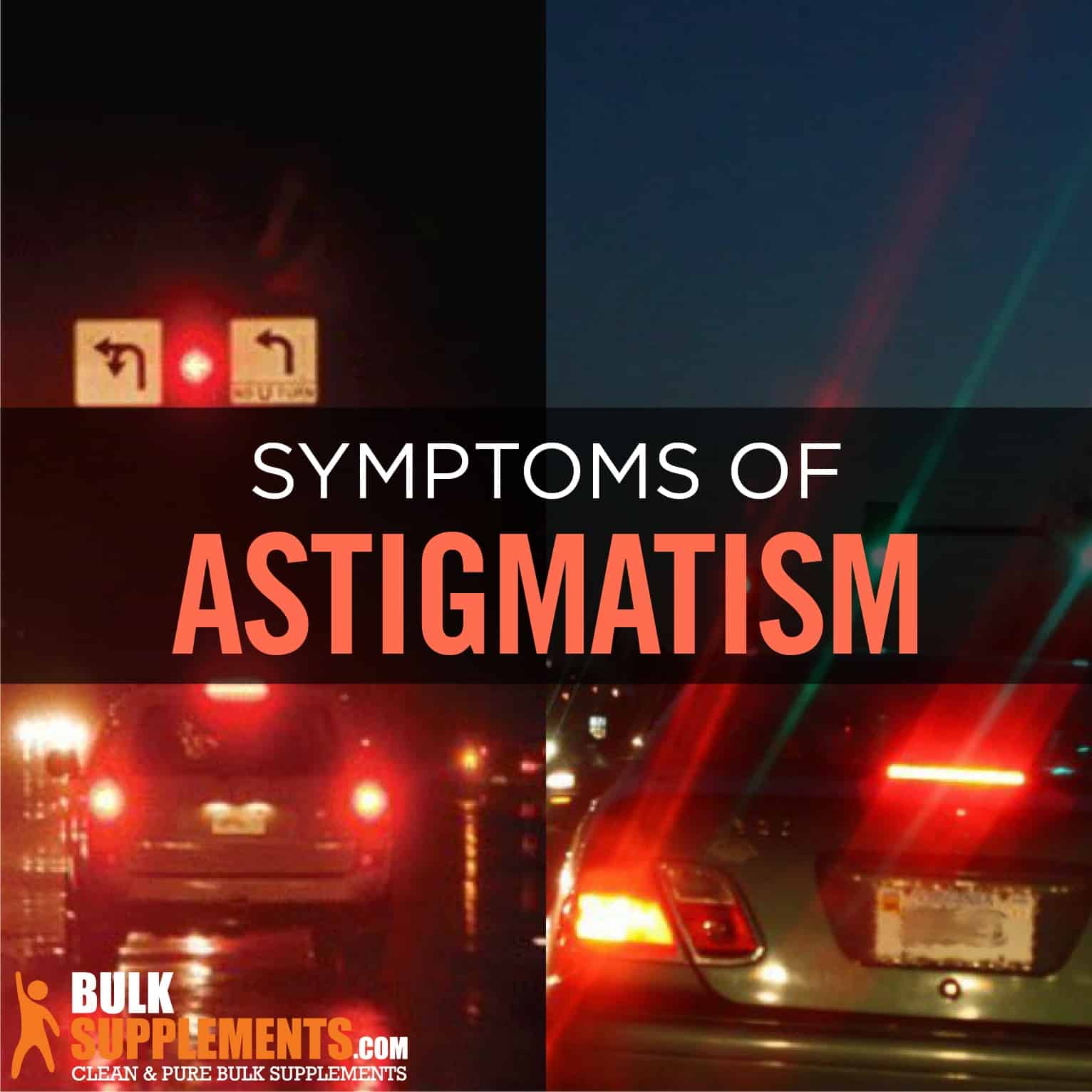What is Astigmatism?
Astigmatism is a common visual problem that results in blurry vision. Astigmatism is caused by an abnormal curvature in the cornea that prevents light from focusing correctly onto the retina. The retina is the light-sensitive area of nerves that rely on a properly focused beam of light that passes through the cornea (x). Astigmatism causes blurred vision. But unlike nearsightedness or farsightedness, vision is blurry regardless of distance. However, astigmatism commonly occurs along with farsightedness and nearsightedness (x). Doctors have not identified the specific cause of astigmatism. It can result from an injury to the eye, it may develop over time or the patient may inherit it.
Blurred vision and eye squinting can be symptoms of many eye problems, including astigmatism. It may also cause the patient to see halos or spikes around points of light at nighttime, which may make it difficult to drive at night. What level of astigmatism requires glasses? Astigmatism is measured in diopters. Most people’s eyes fall somewhere between 0.5 and 0.75 diopters. At 1.5 diopters, the patient requires glasses or contact lenses.
Symptoms of Astigmatism
Astigmatism, nearsightedness and farsightedness are all refraction errors. Nearsightedness and farsightedness develops because the cornea’s focus is too close or too far from the retina. But astigmatism blurs the light falling on the retina (x). There are several signs of astigmatism, including (x):
- Headaches
- Eyestrain
- Squinting
- Distorted or blurry vision from near and far distances
- Difficulty driving at night
One of the common signs of poor vision is consistent headaches. Nearsightedness, farsightedness and astigmatism that is left uncorrected can all cause headaches from eye strain. The muscles in the eye make minute adjustments to bring objects into focus. When objects are out of focus, these muscles work overtime, which causes headaches. However, some patients may also have astigmatism without showing any symptoms (x). Therefore, the only way to know if a patient has astigmatism is to get a comprehensive eye examination from an optometrist or ophthalmologist.
Health Risks Associated with Astigmatism
There are no systemic health risks associated with astigmatism. The condition by itself does not indicate that the patient has a disease process or tissue pathology. But blurred vision from uncorrected astigmatism can cause symptoms that may impact everyday life, including fatigue, headaches, impaired vision and eyestrain (x).

What Causes Astigmatism?
The curvature in the cornea and lens bends light that enters the eye in order to focus it precisely on the retina at the back of the eye. In astigmatism, the surface of the cornea or lens has a slightly different curvature that causes the focal point to smear. Imagine the shape of a normal cornea being round, like a baseball. But a patient with astigmatism has a cornea that looks more elliptical, like a football (x).
It is possible for the curvature inside the eye to change over time. This change can lead to a decrease or increase in astigmatism. This type of change may take place in adulthood and may cause cataracts (x). Sometimes astigmatism may occur after an eye injury or eye surgery. It can develop at any age.
A rare condition called keratoconus causes the cornea to take a cone shape, leading to severe astigmatism. Keratoconus requires treatment with contact lenses and often requires a corneal transplant for a lasting solution (x).
How is Astigmatism Diagnosed?
The best way for a patient to tell if they have astigmatism is to have an eye exam by an optometrist. The doctor will make the diagnosis based on a comprehensive dilated eye exam. The exam typically includes dilation, a visual field test, a visual acuity test and tonometry. Dilation is an essential portion for astigmatism diagnosis because it shows an image of the inside of the eye to examine it. It’s important to have an annual comprehensive dilated eye exam, generally starting from age 60 to detect any problems (x).
Infants and children can also suffer from astigmatism. An optometrist will be able to diagnose the condition in younger patients as well. Starting eye exams before a child is one year old can help mitigate the effects of astigmatism (x). The sooner children have their vision corrected, usually with glasses, the less impact astigmatism will have on their balance, coordination and spatial awareness (x).
Measuring Astigmatism
Optometrists measure astigmatism by the degree of curvature in the cornea. They measure astigmatism in units called diopters. A diopter of .75 or less does not require correction. Any diopter measurement above 1.25 will require corrective lenses (x, x).
How is Astigmatism Treated?
Eyeglasses are the number one treatment option for patients with astigmatism. Eyeglasses can correct nearsightedness or farsightedness and they can correct astigmatism at the same time. For people over 40 with presbyopia, bifocals are the most effective option (x).
Contact lenses are also an option. Toric soft contact lenses tend to work best for astigmatism (x). Regular soft lenses may not completely treat the condition. Toric soft contact lenses compensate for the elliptical curve of the cornea and help improve vision (x). Toric soft contacts or toric gas-permeable rigid contacts are the best option for patients with dry eyes (x).
Orthokeratology (ortho-K) corrects astigmatism temporarily (x, x). The process is painless and noninvasive. The patient wears corrective rigid contact lenses that reshape the cornea’s curvature over time (x). Think of braces that correct misaligned teeth, slowly bringing them into alignment. But unlike braces, ortho-K works quickly, with noticeable improvement overnight. However, once the patient stops wearing the lenses, astigmatism usually returns (x).
Can LASIK Correct Astigmatism?
LASIK surgery can completely and permanently correct most cases of astigmatism (x). Laser eye surgery for astigmatism is usually performed with the LASIK procedure or the PRK (photorefractive keratectomy) procedures. Wavefront LASIK is a type of LASIK that is particularly effective for correcting it. Wavefront LASIK is the procedure of choice for people with moderate to severe astigmatism (x).
Supplements for Eye Health
Dietary supplements for eye health do not correct vision problems that the curvature in the cornea causes. But they may be able to help increase the health of the eye tissues themselves. Always consult a physician before starting a supplement regimen and follow all medical advice.
Fish Oil (Omega-3 Fatty Acids)
Essential fatty acids like omega-3 fatty acids are necessary for eye health. Fish oil with omega-3 fatty acids contain docosahexaenoic acid (DHA), eicosapentaenoic acid (EPA) and alpha-linolenic acid (ALA). Not only do these fatty acids help alleviate symptoms of dry-eye syndrome, they are also necessary for healthy eye development in infants (x). Take three omega 3-6-9 softgels daily as a dietary supplement, unless a doctor suggests a different dosage.
Beta Carotene
In combination with zinc, beta carotene is known for its ability to help vision (x). Beta carotene, Vitamin E and Vitamin A are all fat-soluble nutrients that are necessary for many vital life functions (x). As a dietary supplement, take 1,300 mg (about 1/2 tsp) daily of pure beta carotene powder or as directed by a physician.
Pure Lutein Powder
Both zeaxanthin and lutein absorb high-energy light emissions called blue light (x). Blue light is highly energetic and can damage the macula, a critical area for vision in the back of the eye (x). Take 400 mg (1/8 tsp) of pure lutein powder daily, or as directed by physician.
Zeaxanthin 5% Powder
Zeaxanthin, like lutein, is a carotenoid (x). Both are powerful antioxidants that remove free radicals from tissues, which become particularly helpful in delicate retinal and macular cells. Take 100 mg of pure zeaxanthin powder one to two times daily, or as directed by a physician.
Zinc Orotate Powder
This mineral is essential for wound healing and eye health (x). Zinc is concentrated in the skin and in the retina. As a dietary supplement, take 100 mg of pure zinc orotate powder one to three times per day, as long as a physician approves the dosage.
Vitamin A
Dark green leafy vegetables are rich in Vitamin A, as are carrots and winter squash. Vitamin A is essential for healthy eyes. As a dietary supplement, take 30 mg of pure Vitamin A palmitate powder daily, or as directed by physician.
Vitamin B
The B vitamins, specifically Vitamin B6 and Vitamin B12, contribute to healthy eyes and good vision. The recommended dosage for pure Vitamin B6 powder is 50 mg once a day, or as directed by a physician. Never consume more than 125 mg per day under any circumstances. Take 100 to 200 mg of Vitamin B12 powder, unless a physician recommends another dosage.
Vitamin C
Ascorbic acid, or Vitamin C, is crucial in the formation of connective tissues, including the collagen that forms the cornea. Consuming ascorbic acid long-term may reduce the risk of macular degeneration, a leading cause of blindness (x, x). Take 1,000 mg of Vitamin C powder up to four times a day.
The Bottom Line
Astigmatism is a common, correctable vision problem. The condition forms when there is an abnormal curvature in the cornea that prevents light from focusing correctly on the retina. It causes blurry vision, headaches and eye strain. By itself, the condition does not signal any underlying disease process and may be corrected with contacts or eyeglasses. Many supplements are available that assist in maintaining good overall health as well as contribute to greater eye health. Always consult a doctor before starting a supplement regimen.


